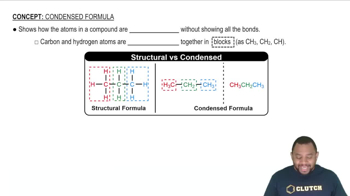Here are the essential concepts you must grasp in order to answer the question correctly.
Condensed Structures
Condensed structures are a simplified way of representing molecular structures where atoms are grouped together to show connectivity without depicting every bond explicitly. In these structures, carbon and hydrogen atoms are often implied rather than shown, making it easier to visualize larger molecules. For example, the condensed structure of butane is written as CH3(CH2)2CH3, indicating the arrangement of carbon and hydrogen atoms without drawing each bond.
Recommended video:
Line Drawings (Skeletal Structures)
Line drawings, or skeletal structures, are a graphical representation of organic molecules where carbon atoms are represented by the ends and intersections of lines, while hydrogen atoms are usually omitted for clarity. Each vertex represents a carbon atom, and the lines represent bonds between them. This method allows chemists to quickly convey complex structures in a clear and concise manner, focusing on functional groups and overall molecular shape.
Recommended video:
Functional Groups
Functional groups are specific groups of atoms within molecules that are responsible for the characteristic chemical reactions of those molecules. They determine the properties and reactivity of organic compounds. Common functional groups include hydroxyl (-OH), carboxyl (-COOH), and amino (-NH2) groups, which can be easily identified in both condensed structures and line drawings, aiding in the understanding of a molecule's behavior in chemical reactions.
Recommended video:
Carbonyl Functional Groups

 Verified step by step guidance
Verified step by step guidance


